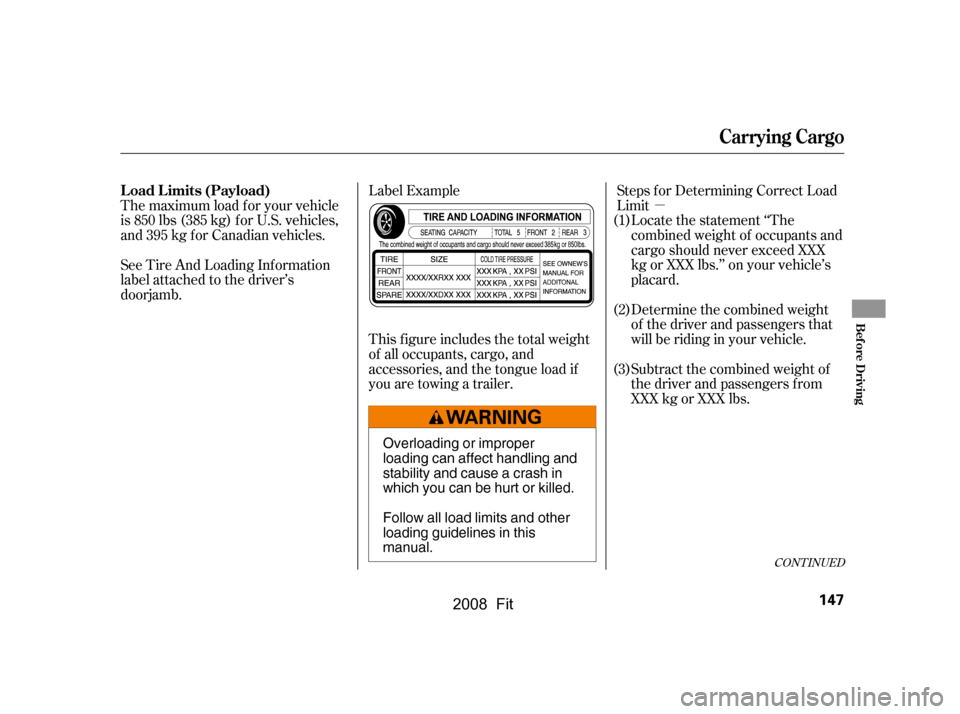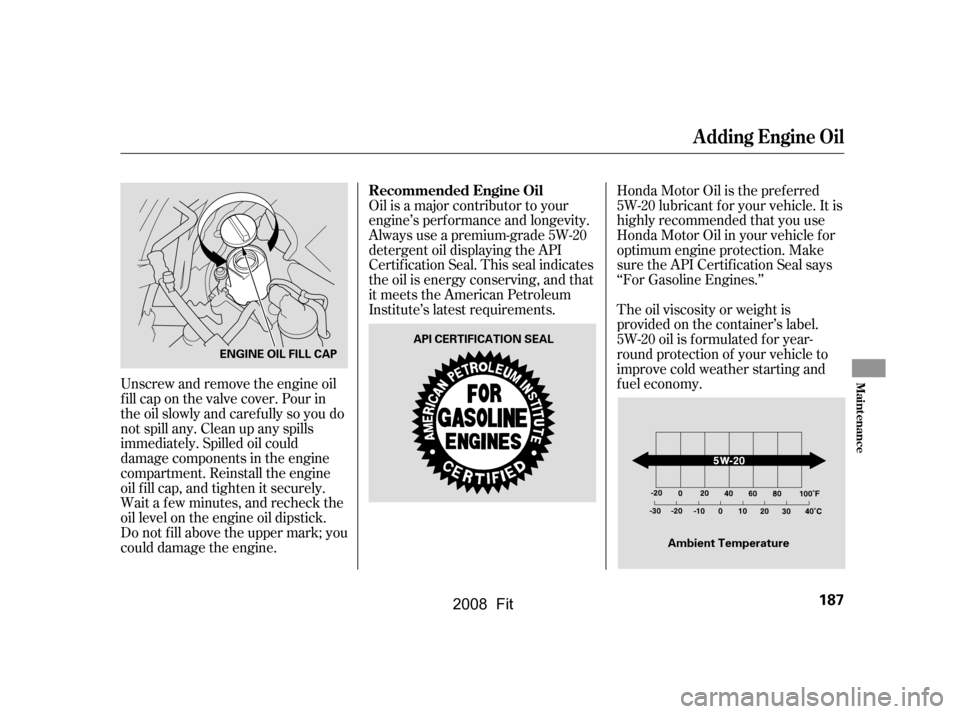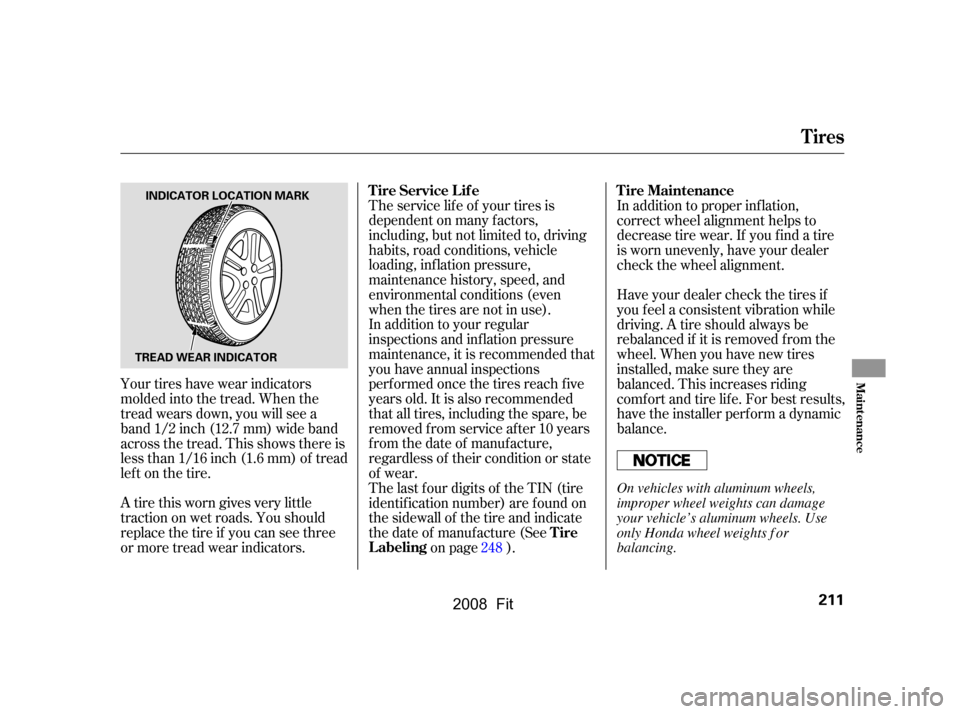Page 150 of 280

�µ
Locate the statement ‘‘The
combined weight of occupants and
cargo should never exceed XXX
kg or XXX lbs.’’ on your vehicle’s
placard.
Determine the combined weight
of the driver and passengers that
will be riding in your vehicle.
Subtract the combined weight of
the driver and passengers f rom
XXX kg or XXX lbs.
The maximum load f or your vehicle
is 850 lbs (385 kg) f or U.S. vehicles,
and 395 kg for Canadian vehicles.
See Tire And Loading Inf ormation
label attached to the driver’s
doorjamb.
Label Example
This f igure includes the total weight
of all occupants, cargo, and
accessories, and the tongue load if
you are towing a trailer.Steps f or Determining Correct Load
Limit
(1)
(2)
(3)
CONT INUED
Carrying Cargo
L oad L imits (Payload)
Bef ore Driving
147
Overloading or improper
loading can affect handling and
stability and cause a crash in
which you can be hurt or killed.
Follow all load limits and other
loading guidelines in this
manual.
�\f���—�\f���—�����y���\f�����������y���
�(�������
�\f�y�\f�
�����y
2008 Fit
Page 151 of 280

�µ�·
The resulting f igure equals the
available amount of cargo and
luggage load capacity. For
example, if the ‘‘XXX’’ amount
equals 1,400 lbs. and there will be
f ive 150 lb. passengers in your
vehicle, the amount of available
cargo and luggage load capacity is
650 lbs.
(1,400 750 (5 150) = 650 lbs.)
Determine the combined weight
of luggage and cargo being loaded
on the vehicle. That weight may
not saf ely exceed the available
cargo and luggage load capacity
calculated in Step 4.
If your vehicle will be towing a
trailer, load f rom your trailer will
be transf erred to your vehicle.
Consult this manual to determine
how this reduces the available
cargo and luggage load capacity of
your vehicle.
In addition, the total weight of the
vehicle, all occupants, accessories,
cargo, and trailer tongue load must
not exceed the Gross Vehicle
Weight Rating (GVWR) or the Gross
Axle Weight Rating (GAWR). Both
areonalabelonthedriver’s
doorjamb.Example 1
Example 2
Example 3
(4)
(5)
(6)
Carrying Cargo
148
Passenger Weight
(150lbsx2=300lbs)
Passenger Weight
(150lbsx4=600lbs)
Passenger Weight
(150lbsx5=750lbs)
Max Load (850 lbs)
Max Load (850 lbs)
Max Load (850 lbs)
Cargo Weight
(550 lbs)
Cargo Weight
(250 lbs)
Cargo Weight
(100 lbs)
�\f���—�\f���—�����y���\f�����������y���
�(�������
�\f�y�\f�
�����y
2008 Fit
Page 153 of 280
Theseparationnetcanbeusedto
hold back sof t, lightweight items
stored in the cargo area. Heavy
items should be properly secured on
the f loor of the cargo area. The net
may not prevent heavy items f rom
being thrown f orward in a crash or a
sudden stop.The f our hooks on the f loor can be
used to install a net f or securing
items.
Optional Separation Net
Carrying Cargo
150
HOOK
�\f���—�\f���—�����y���\f�������\f�\f�y���
�(�������
�\f�y�\f�
�����y
2008 Fit
Page 190 of 280

Honda Motor Oil is the pref erred
5W-20 lubricant f or your vehicle. It is
highly recommended that you use
Honda Motor Oil in your vehicle f or
optimum engine protection. Make
sure the API Certif ication Seal says
‘‘For Gasoline Engines.’’
The oil viscosity or weight is
provided on the container’s label.
5W-20 oil is f ormulated f or year-
round protection of your vehicle to
improve cold weather starting and
f uel economy.
Oil is a major contributor to your
engine’s perf ormance and longevity.
Always use a premium-grade 5W-20
detergent oil displaying the API
Certif ication Seal. This seal indicates
the oil is energy conserving, and that
it meets the American Petroleum
Institute’s latest requirements.
Unscrew and remove the engine oil
fill cap on the valve cover. Pour in
the oil slowly and caref ully so you do
not spill any. Clean up any spills
immediately. Spilled oil could
damage components in the engine
compartment. Reinstall the engine
oil f ill cap, and tighten it securely.
Wait a f ew minutes, and recheck the
oil level on the engine oil dipstick.
Do not f ill above the upper mark; you
could damage the engine.
A dding Engine Oil
Recommended Engine Oil
Maint enance
187
API CERTIFICATION SEAL
Ambient Temperature
ENGINE OIL FILL CAP
�\f���—�\f���—�����y���\f����\f������y���
�(�������
�\f�y�\f�
�����y
2008 Fit
Page 191 of 280

Your vehicle does not require any oil
additives. Additives may adversely
af f ect the engine or transmission
perf ormance and durability.Run the engine until it reaches
normal operating temperature,
then shut it off.
Open the hood, and remove the
engine oil f ill cap. Remove the oil
drain bolt and washer f rom the
bottom of the engine. Drain the oil
into an appropriate container.
Always change the oil and f ilter
according to the maintenance
messages shown on the inf ormation
display. The oil and f ilter collect
contaminants that can damage your
engine if they are not removed
regularly.
Changing the oil and f ilter requires
special tools and access f rom
underneath the vehicle. The vehicle
should be raised on a service station-
type hydraulic lif t f or this service.
Unless you have the knowledge and
proper equipment, you should have
this maintenance done by a skilled
mechanic.
You may use a synthetic motor oil if
it meets the same requirements
given f or a conventional motor oil, it
displays the API Certif ication Seal,
and it is the proper weight. You must
f ollow the oil and f ilter change
intervals given in the maintenance
schedule.
1.
2.
Synthetic Oil
Engine Oil A dditives
Changing the Engine Oil and
Filter
A dding Engine Oil, Changing the Engine Oil and Filter
188
WASHER
OIL DRAIN BOLT
�\f���—�\f���—�����y���\f����\f������y���
�(�������
�\f�y�\f�
�����y
2008 Fit
Page 206 of 280
Dirt build-up in the loops of the seat
belt anchors can cause the belts to
retract slowly. Wipe the insides of
the loops with a clean cloth
dampened in mild soap and warm
water or isopropyl alcohol.
If your seat belts get dirty, use a sof t
brush with a mixture of mild soap
and warm water to clean them. Do
not use bleach, dye, or cleaning
solvents. Let the belts air-dry bef ore
you use the vehicle. If your vehicle is equipped with
genuine Honda f loor mats, the mats
hook over f loor mat anchors. This
keeps the f loor mats f rom sliding
f orward and possibly interf ering with
the pedals or making the front
passenger’s weight sensors
inef f ective.
CONT INUED
Cleaning the Seat Belts Floor Mats
(Optional)
Cleaning the Seat Belts, Floor Mats
Maint enance
203
FRONT
LOOP
�\f���—�\f���—�����y���\f�����������y���
�(�������
�\f�y�\f���\f���y
2008 Fit
Page 207 of 280
A non-Honda f loor mat may not f it
your vehicle properly. This could
prevent the proper operation of the
f olding rear seats and the passenger’s
seat weight sensors. We recommend
using genuine Honda f loor mats. Do
not put additional f loor mats on top
of the anchored mats.
If you remove a f loor mat, make sure
tore-anchoritwhenyouputitback
in your vehicle.
Foor Mats, Audio Antenna
A udio A ntenna
204
REAR
Your vehicle is equipped with an
antenna at the rear of the roof . Bef ore
using a ‘‘drive-through’’ car wash,
remove the antenna by unscrewing it by
hand. This prevents the antenna f rom
being damaged by the car wash brushes.
�\f���—�\f���—�����y���\f�����������y���
�(�������
�\f�y�\f���\f���y
2008 Fit
Page 214 of 280

The service lif e of your tires is
dependent on many f actors,
including, but not limited to, driving
habits, road conditions, vehicle
loading, inf lation pressure,
maintenance history, speed, and
environmental conditions (even
when the tires are not in use).
In addition to your regular
inspections and inf lation pressure
maintenance, it is recommended that
you have annual inspections
perf ormed once the tires reach f ive
years old. It is also recommended
that all tires, including the spare, be
removed from service after 10 years
from the date of manufacture,
regardless of their condition or state
of wear.
Your tires have wear indicators
molded into the tread. When the
tread wears down, you will see a
band 1/2 inch (12.7 mm) wide band
across the tread. This shows there is
less than 1/16 inch (1.6 mm) of tread
lef t on the tire.
A tire this worn gives very little
traction on wet roads. You should
replace the tire if you can see three
or more tread wear indicators. In addition to proper inf lation,
correct wheel alignment helps to
decrease tire wear. If you f ind a tire
is worn unevenly, have your dealer
check the wheel alignment.
Have your dealer check the tires if
you f eel a consistent vibration while
driving. A tire should always be
rebalanced if it is removed f rom the
wheel. When you have new tires
installed, make sure they are
balanced. This increases riding
comf ort and tire lif e. For best results,
have the installer perform a dynamic
balance.
The last f our digits of the TIN (tire
identif ication number) are f ound on
the sidewall of the tire and indicate
the date of manufacture (See on page ).248
Tires
T ire Service L if e T ire Maintenance
Tire
Labeling
Maint enance
211
TREAD WEAR INDICATOR INDICATOR LOCATION MARK
On vehicles with aluminum wheels,
improper wheel weights can damage
your vehicle’s aluminum wheels. Use
only Honda wheel weights f or
balancing.
�\f���—�\f���—�����y���\f�����������y���
�(�������
�\f�y�\f���
���y
2008 Fit